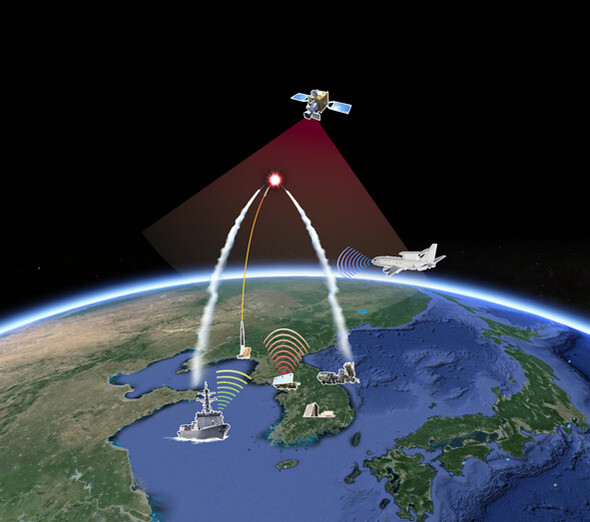hankyoreh
Links to other country sites 다른 나라 사이트 링크
South Korea’s missile defense could be incorporated into US system

By Park Byong-su, staff reporter
South Korea’s Air and Missile Defense (KAMD) system is becoming a key issue in discussions on the transfer of wartime operational command (OPCON) from the US.
The two countries discussed preparing a response to North Korea’s increased nuclear and missile capabilities on Oct. 2. But the incorporation of South Korea’s system into the one led by the US stands to trigger objections from China, which sees itself a target.
US Secretary of Defense Chuck Hagel said at a press conference on Oct. 2 that “The South Korean and US missile defense systems don’t have to be identical as long as they are interoperable.” His remarks suggested that South Korea is not obliged to take part in the US system, but that the two countries’ systems should allow for linkages and interoperation.
The KAMD, which is now in the planning stages, would be in place and capable of intercepting North Korean missiles by 2022 at the latest.
A source with the South Korean military interpreted Hagel’s remarks as meaning that “there is no need for South Korea’s missile defense system to be integrated into the US’s . . . but the two sides need to exchange information on North Korean missile launches.”
Another source said on condition of anonymity, “In an environment like the Korean Peninsula where firing ranges are so short, the most effective missile defense system is low-altitude defense. We’re not participating in any system for high-altitude defense.”
Both South and North Korea have maximum firing ranges of just 1,000 km. The US missile defense system, in contrast, would be designed mainly to intercept intercontinental ballistic missiles.
Many are still concerned that the South Korean system could end up being incorporated into the US system.
“Chuck Hagel’s reference to ‘interoperability’ means linking the South Korean and US missile defense systems, plain and simple,” said Kim Jong-dae, editor-in-chief of the defense journal Defense 21+.
“It certainly seems that the US is using Seoul’s request for another postponement as a way of accomplishing its own longstanding desire to building a three-way missile defense system with South Korea and Japan,” Kim added.
Senior US officials have recently been speaking publicly on the issue. Gen. Martin Dempsey, chairman of the US Joint Chiefs of Staff, discussed a “joint integrated missile defense system” while speaking to reporters on Sept. 30, saying that North Korean ballistic missiles pose a threat both to the Korean Peninsula and to regional security.
Adm. Samuel Locklear, who leads the US Pacific Command, said on Oct. 1 that one of the most important concerns was developing a regional missile defense network capable of protecting the Korean Peninsula and supporting the entire region.
Please direct questions or comments to [english@hani.co.kr]

Editorial・opinion
![[Column] Park Geun-hye déjà vu in Yoon Suk-yeol [Column] Park Geun-hye déjà vu in Yoon Suk-yeol](https://flexible.img.hani.co.kr/flexible/normal/500/300/imgdb/original/2024/0424/651713945113788.jpg) [Column] Park Geun-hye déjà vu in Yoon Suk-yeol
[Column] Park Geun-hye déjà vu in Yoon Suk-yeol![[Editorial] New weight of N. Korea’s nuclear threats makes dialogue all the more urgent [Editorial] New weight of N. Korea’s nuclear threats makes dialogue all the more urgent](https://flexible.img.hani.co.kr/flexible/normal/500/300/imgdb/original/2024/0424/7317139454662664.jpg) [Editorial] New weight of N. Korea’s nuclear threats makes dialogue all the more urgent
[Editorial] New weight of N. Korea’s nuclear threats makes dialogue all the more urgent- [Guest essay] The real reason Korea’s new right wants to dub Rhee a founding father
- [Column] ‘Choson’: Is it time we start referring to N. Korea in its own terms?
- [Editorial] Japan’s rewriting of history with Korea has gone too far
- [Column] The president’s questionable capacity for dialogue
- [Column] Are chaebol firms just pizza pies for families to divvy up as they please?
- [Column] Has Korea, too, crossed the Rubicon on China?
- [Correspondent’s column] In Japan’s alliance with US, echoes of its past alliances with UK
- [Editorial] Does Yoon think the Korean public is wrong?
Most viewed articles
- 1[Column] Park Geun-hye déjà vu in Yoon Suk-yeol
- 2N. Korean hackers breached 10 defense contractors in South for months, police say
- 3Thursday to mark start of resignations by senior doctors amid standoff with government
- 4[Editorial] New weight of N. Korea’s nuclear threats makes dialogue all the more urgent
- 5Kim Jong-un expressed ‘satisfaction’ with nuclear counterstrike drill directed at South
- 6Will NewJeans end up collateral damage in internal feud at K-pop juggernaut Hybe?
- 7[Editorial] Japan’s rewriting of history with Korea has gone too far
- 8[Cine feature] A new shift in the Korean film investment and distribution market
- 9[Column] ‘Choson’: Is it time we start referring to N. Korea in its own terms?
- 10[Column] The clock is ticking for Korea’s first lady